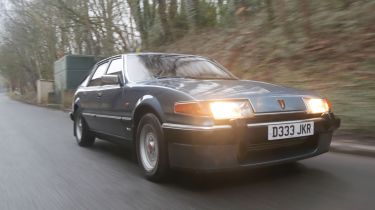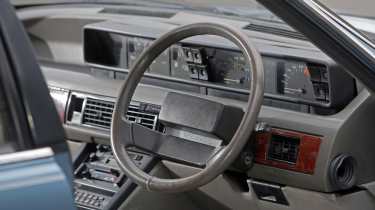Rover SD1 (1976-1986) icon review: not just a pretty face
With Ferrari-inspired styling and a V8 under the bonnet, Rover’s executive hatch had potential
It was 60 years ago that the first European Car of the Year was unveiled. A technological tour de force, the Rover P6 was a worthy winner, and the next year the Brits scooped gold with the Austin 1800 Landcrab. Fast forward to 1977 and it was the Rover SD1’s turn, but this would be the last time an all-British product won the award.
The SD1 was lauded at launch and is revered by many, but for much of its 48-year existence, this smart-looking hatchback was derided as rubbish, purely because it was from British Leyland. For many, BL is synonymous with shoddy and undesirable cars, but when the SD1 was unveiled at the Chateau Impney hotel in Droitwich in 1976, things were more upbeat. The new arrival attracted rave reviews, and a lengthy waiting list soon developed.
When development of the SD1 began in 1969, it was codenamed P10, and it was set to take over from the P6 at some point in the mid-seventies. The P6 had in-house competition from the Triumph 2000/2500, so it was decided that one large Rover would replace both models. The engineering departments of the two brands would be combined to form BL’s new Specialist Division, and its first product would be this executive express called the Specialist Division 1, or SD1.
Used - available now
In some ways the new arrival was less ambitious than the P6. Denis Chick worked in product development for BL at the time and was a planner for the new Rover. He says: “The SD1 was going to be much more cutting-edge when we started, but then the bean counters took over and everything was pared back. In effect we ended up with a Rover-bodied Cortina – a car that did a perfectly good job, but didn’t push any boundaries. The SD1 should have had sophisticated suspension, which was Rover’s speciality, but the car was hugely under-developed when it came to market. Money was draining from the company through inefficiencies enforced by the unions, while the workforce seemed uninterested in building the cars to a high standard.”
The SD1’s cabin was filled with moulded plastic trim and there was just one engine: a carburetted 3.5-litre V8 with 155bhp. What set the Rover apart from rivals such as the Ford Granada, Peugeot 604, Vauxhall Carlton and Volvo 240, was its hatchback configuration. Most cars in this segment were traditional saloons or utilitarian estates, but with its folding back seats, the SD1 offered practicality that those alternatives couldn’t match.
Unfortunately the SD1 missed the mark set by the German brands for build quality, but back then the BMW 5 Series and Audi 100 sold in tiny numbers, while the Mercedes W123 was expensive and poorly equipped.
Spen King (who had also led the original Range Rover project) was in overall charge of BL’s new executive car, which was designed by David Bache and engineered by Gordon Bashford. By the time it reached production, the rakish five-door Rover SD1 hatchback looked sensational in a very conservative segment.
The SD1 wasn’t just a pretty face though. Under that Ferrari Daytona-inspired skin, Rover’s V8 sent power to the rear wheels via an all-new five-speed manual gearbox, or there was a three-speed automatic. The front suspension was by MacPherson struts and coil springs, while at the back was a live axle located by a Watt’s linkage and coil springs, and the whole shooting match featured Boge self-levelling tech. Power-assisted rack-and-pinion steering was standard, while the braking system was a disc/drum set-up.
As an executive car, the SD1 wasn’t short of standard equipment, which included a Triplex laminated windscreen, two-speaker radio, tinted glass, central locking and an internally adjustable offside door mirror. At launch there were just six options: the auto box (£149.76), electric windows front and rear (£99.45) and inertia-reel seatbelts for the back seats (£35.10). Dunlop Denovo run-flat tyres were listed at £91.26, or a set of alloy wheels with 195-section tyres was an alternative at £175.50. The final option was an internally adjustable passenger door mirror, at £19.89. Without options the SD1 3500 was listed at £4,740.
Much of the £95million that BL invested in the SD1’s development was spent on a factory that was designed to meet NATO-approved Ministry of Defence quality- control standards. That’s why the SD1 was supposedly so well protected against corrosion; the bodyshell was coated with an electrophoretic primer and topped with a thermoplastic paint, while the sills were zinc plated. But the SD1 soon gained a reputation for poor reliability, with peeling paint, detached interior trim, part-time electrics and water leaks, thanks to a raft of cost-cutting measures throughout its development and manufacture.
Unsurprisingly, used values took a hit, and despite that long initial waiting list, it didn’t take long for Ford’s Granada to outsell the SD1, including with police forces who had initially embraced the big Rover, only to be disappointed by one problem after another. Many cut their contracts short and returned their cars early.
For the first year of SD1 production the P6 was sold alongside it, but by 1977 there were 2.3 and 2.6-litre editions featuring a straight-six sourced from Triumph. Two years later came the 3.5-litre V8-S, a precursor to the Vitesse with gold alloy wheels, metallic paint and leather trim, but the same 155bhp V8 as the regular car.
The big year for the SD1 was 1982, when it received a substantial facelift. The Series 2 brought a bigger rear window and smoother front end with flush-fitting headlamps, bigger bumpers and a new entry-level 2000 model with a 2.0-litre four-cylinder engine. The interior was also heavily revised, with a new dashboard. Soon after, the 2400SD turbodiesel was added, along with the version everyone now wants: the Vitesse, with a 190bhp fuel-injected 3.5-litre V8 and lowered suspension.
Although the Rover 800 was launched in 1986, the final SD1 wouldn’t be produced in the UK until the following year, while in 1985 Rover licensed production to India’s Standard Motor Products. But with only a lacklustre 2.0-litre four-cylinder engine and optimistic pricing, sales were slow. Despite this around 8,000 SD1s were made in Madras; that was on top of the 303,345 examples built in the UK.
Rover released the ultimate SD1 in 1985: the Twin Plenum Vitesse. A homologation special for the 1986 European Touring Car Championship, this last hurrah featured a twin-throttle plenum fuel-injection system, and although it’s rated at the same 190bhp as the regular Vitesse, these have become the Holy Grail of SD1s for collectors, with around 500 made.
Even before the Twin Plenum arrived, the SD1 enjoyed much success on track, scooping the 1983 RAC Tourist Trophy, 1984 British Saloon Car Championship and a class win in the 1984 Bathurst 1000 in Australia. The Vitesse would also win half a dozen rounds of the 1985 ETCC and five rounds in 1986, all of which led to Austin Rover’s advertising slogan ‘We race, you win’.
The car pictured here is a Twin Plenum Vitesse, and it belongs to Richard Usher, who set up the Great British Car Journey in Derbyshire, a museum dedicated to charting the history of the British car industry. It’s one of the last SD1s made, after the introduction of the 800 that was developed in conjunction with Honda.
Settle into the velour-trimmed driver’s seat and the first impression is one of luxury, with comprehensive full-width instrumentation, electric windows all round, and some fillets of wood to add to the ambience. There’s also a trip computer, a sliding steel sunroof and acres of space; this is a proper five-seater with plenty of room for all the family.
Fire up the all-alloy V8 and it quickly settles into a smooth idle, but the Vitesse doesn’t feel especially urgent. The engine is well endowed with torque (300Nm at 4,000rpm), but with a kerbweight of almost 1.5 tonnes, this is no featherweight executive. Add in a vague gearchange and it’s clear that this isn’t a car for hustling; it’s much better suited to long-distance cruising, where you can let the V8’s muscle just waft you along. And that’s exactly what the SD1 does; the soft suspension soaks up bumps that would have your teeth rattling in a modern car, and the ride is also helped by the fitment of relatively high-profile tyres (205/60 15); the trade-off is lots of roll in the bends.
As the SD1’s golden anniversary rushes headlong towards us, examples that would previously have been scrapped are now being restored, proving how this landmark Rover has bounced back. That’s just as well, because only one per cent of the SD1s produced have survived, and just half of those are on the road. So if you fancy your own Division One classic, you’d better join the club and start your hunt.
Interested in buying one?
Join the SD1 Club (roversd1club.net) and you’ll be able to find your dream car, although if you’re picky, you might have to wait. Most variations come up for sale sooner or later, with V8 editions fetching £7,000-£20,000, depending on spec and condition. The best six-cylinder 2600 Vanden Plas is worth no more than £10,000.
Series 1 SD1s are rare because they rotted so badly; later cars fare better but you still need to check the bodywork carefully. However, panel availability is surprisingly good at sensible prices. The same is also true of most of the running gear, although many parts for the four-cylinder engines (petrol and diesel) are hard to come by.
Six-cylinder engines are durable if the oil is changed regularly, but most remaining SD1s are V8s, either carburetted or fuel-injected, and these also need frequent oil and coolant changes. Diffs and steering racks are prone to leaks, while tired trim and dodgy electrics are par for the course.















